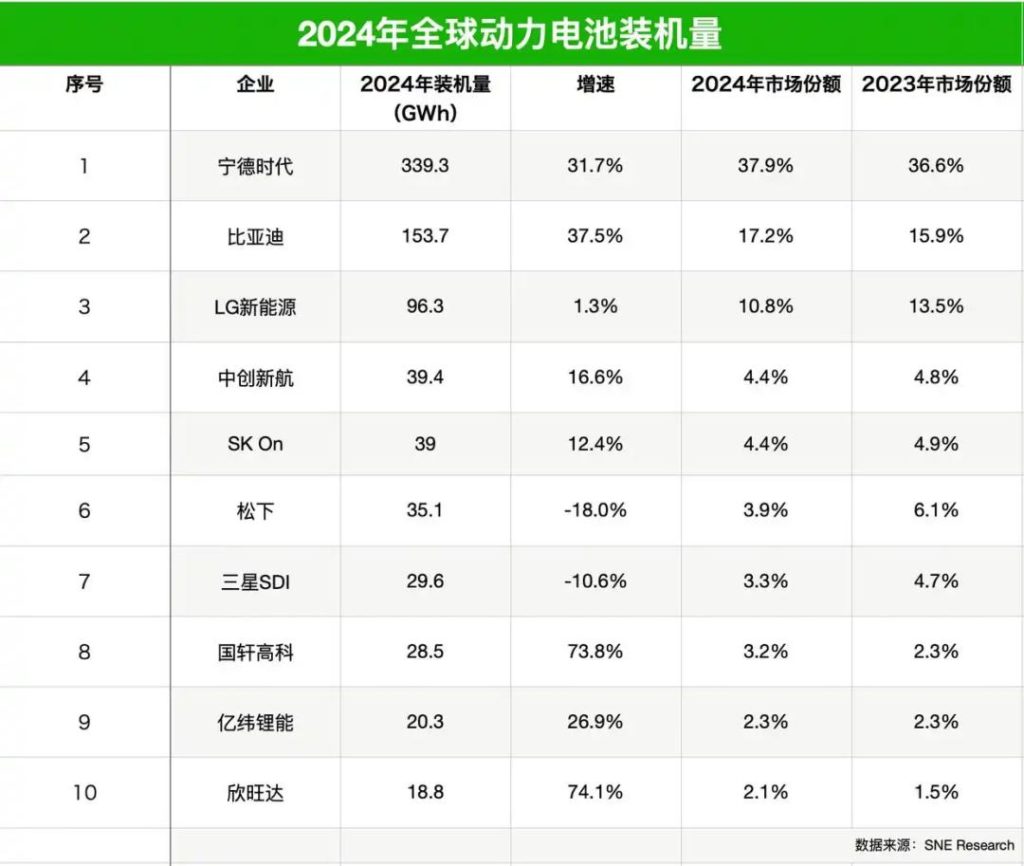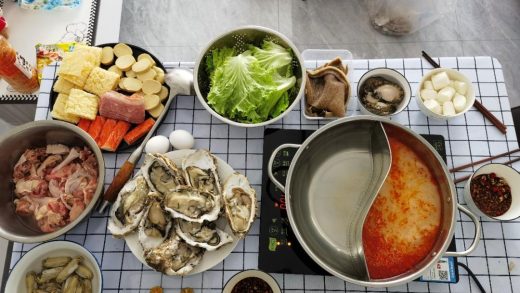
Read More《中国电池卖到欧洲,结果被日韩企业盯上了?》
Positive Comments: The Rise of Chinese Battery Enterprises Forces the Reshaping of the Global Industrial Landscape, and Patent Litigation Accelerates the Process of Technological Autonomy
In recent years, the global rise of China’s battery industry has become an undeniable trend. According to the data mentioned in the news, among the top 10 global power battery installation volumes in 2024, Chinese enterprises occupied 6 seats and all achieved double – digit growth. Leading enterprises such as CATL and BYD have rewritten the industry landscape in a way that “overturns the tables of Japanese and South Korean companies”. This rapid breakthrough not only stems from China’s advantages in new energy policies, industrial chain support, and cost control but also reflects a substantial improvement in technological innovation capabilities. From the early stage of relying on reverse R & D to the current launch of iconic technologies such as “Blade Battery” and “Qilin Battery”, Chinese enterprises have gradually shifted from “followers” to “leaders”.
Against this background, the “hunt” launched by Japanese and South Korean enterprises through patent litigation is essentially a passive response to the rise of Chinese enterprises, which also confirms from the side that the competitiveness of China’s battery industry has touched the core interests of the global market. This external pressure objectively becomes an important driving force for promoting the technological autonomy of Chinese enterprises. For example, in the patent dispute between CALB and CATL mentioned in the news, CALB finally went public through technical evasion and counter – sued CATL. This case is a typical example of Chinese enterprises “learning from setbacks” in patent games. When facing patent restrictions, enterprises no longer passively compromise but break through technical barriers through independent R & D and even build their own patent moats.
More notably, the frequent occurrence of patent litigation is accelerating the “patent awakening” of China’s battery industry. In the past, due to the late start and insufficient technical accumulation, Chinese enterprises generally had a tendency to “emphasize the market over patents”, and their patent layouts were mostly concentrated in the application layer rather than the basic layer. However, in recent years, with the intensification of industry competition and the deepening of globalization, leading enterprises have begun to systematically layout their patent systems. For example, as of 2024, CATL has applied for more than 30,000 patents globally, covering the entire chain of battery materials, structural design, and manufacturing processes; BYD has established a significant advantage in the lithium iron phosphate field through the patent protection of core technologies such as the “Blade Battery”. Although the lawsuit against Sunwoda has caused losses in the short term, in the long run, it will prompt more enterprises to plan for patent risks in advance and promote the industry’s transformation from “technological catch – up” to “patent – led”.
In addition, the normalization of global patent litigation is also promoting Chinese enterprises to improve their legal response capabilities. From the early stage when ATL was forced to pay 3% of its revenue as a settlement due to a patent dispute to the current situation where Sunwoda actively initiates a “patent invalidation lawsuit” for defense, Chinese enterprises have shifted from being “passively beaten” to “actively counter – attacking”. This improvement in ability is not only reflected in litigation strategies but also in the familiarity with international patent rules. For example, the LGES patent involved in this lawsuit is about to expire in December 2025, and Chinese enterprises can completely reduce losses through a “delay tactic”, which reflects the enterprises’ precise grasp of the patent validity period.
Negative Comments: Under the Double Pressure of Historical Patent Debts and Alliance Hunts, Chinese Battery Enterprises Face Systemic Risks in Going Global
Although the rise of China’s battery industry is irresistible, the patent injunction that Sunwoda encountered in Germany this time exposes the systemic shortcomings of the industry in the process of globalization, mainly in three aspects:
Firstly, the risk of being “held back by patents” due to historical technological dependence. The early development of China’s battery industry generally relied on reverse R & D of Japanese and South Korean technologies. For example, Wang Chuanfu, the founder of BYD, completed his technical accumulation by disassembling Sony batteries. This “copy – and – paste approach” was necessary in the initial stage of the industry but also buried patent risks. The complexity of battery technology determines that its patent system is “nested layer by layer”. Basic – layer patents (such as separators, electrolytes, and electrode materials) are mostly held by Japanese and South Korean enterprises. Even if Chinese enterprises achieve innovation in the application layer, they may still fall into infringement disputes due to “basic patent coverage”. The battery separator patent involved in this lawsuit is a typical example. The separator is one of the core components of a battery. LGES’s patent covers the “composite porous separator” and its applications. It is difficult for Chinese enterprises to completely avoid risks without pre – arranging alternative technologies or obtaining authorization.
Secondly, the “precise hunt” of Japanese and South Korean patent alliances intensifies the competitive pressure. Tulip Innovation was jointly established by LGES and Panasonic to specifically manage 5,000 battery patents. This “patent pool” model is highly targeted. On the one hand, it reduces litigation costs through centralized management; on the other hand, it forms a dual – barrier of “defense – offense” through patent cross – licensing. As mentioned in the news, LGES has clearly targeted “late – comer enterprises” (mainly referring to Chinese enterprises) as the key litigation targets and claims that at least 580 patents have been infringed, involving key fields such as cylindrical battery processes and high – nickel battery electrolytes. This organized and systematic patent encirclement poses a direct threat to the globalization strategy of Chinese enterprises. Once a key customer (such as the Dacia Spring model) in a core market (such as Europe) is banned from sales, it may trigger a chain reaction and affect the enterprise’s cooperation network in the entire European market.
Thirdly, the “immediate losses” and “long – term reputation damage” caused by patent litigation cannot be ignored. The injunction from the Munich court requires Sunwoda to destroy the infringing batteries, pay compensation, and ban sales, which directly impacts the enterprise’s short – term finances and market share. More importantly, the label of patent infringement may affect customer trust. European automakers have extremely high requirements for the compliance of the supply chain. If Chinese battery enterprises are found to be “patent – infringing”, they may be excluded from the supplier lists of mainstream automakers. In addition, the long cycle (usually 2 – 3 years) and high cost (the legal fees for a single case may exceed tens of millions of dollars) of patent litigation pose a huge pressure on the capital chain of small and medium – sized enterprises, which may delay their technological R & D and market expansion.
Advice for Entrepreneurs: From “Passive Defense” to “Active Layout”, Build a Global Patent Security System
Facing the increasingly complex patent competition environment, Chinese battery enterprises need to build a “security defense line” from the following five aspects:
- Pre – arrange core patents to avoid dependence on basic – layer technologies: Enterprises should establish a dual – wheel – driven mechanism of “technology – patent” and conduct patent retrieval and layout simultaneously during the R & D process. In particular, they should increase investment in the R & D of alternative technologies for the basic patents of Japanese and South Korean enterprises (such as separators, electrolytes, and high – nickel materials). For example, they can explore new materials such as ceramic separators and solid – state electrolytes to avoid falling into patent traps due to “path dependence”.
- Build a defensive patent pool to form bargaining chips for cross – licensing: Referring to the patent pool model of Tulip Innovation, Chinese enterprises can cooperate with industry associations or leading enterprises to integrate their application – layer patents (such as battery structural design and thermal management technology) into a “defensive patent pool”. Through patent cross – licensing, the risk of being sued by a single enterprise can be reduced. At the same time, they can use the scale effect of the patent pool to negotiate with Japanese and South Korean enterprises and strive for more favorable licensing conditions.
- Strengthen global patent compliance management and establish a risk early – warning mechanism: Enterprises need to set up a special intellectual property department to regularly search the patent databases of target markets (such as Europe and the United States) and conduct pre – investigation of infringement risks for the models and technological routes of key customers. For example, before entering the European market, they can entrust professional institutions to conduct a “Freedom to Operate (FTO) analysis” of the patents of enterprises such as LGES and Panasonic to avoid “stepping on mines”.
- Flexibly use legal tools to improve litigation response capabilities: When facing patent litigation, enterprises should comprehensively use legal means such as “patent invalidation declaration”, “prior art defense”, and “jurisdiction objection”. For example, the “patent invalidation lawsuit” initiated by Sunwoda this time is a reasonable strategy, but attention should be paid to collecting evidence that the LGES patent “lacks novelty/creativity” (such as earlier published technical literature). At the same time, they can learn from the experience of CALB and quickly launch “non – infringing version” products through technical evasion design (such as adjusting the separator structure) to reduce market losses.
- Promote the formulation of international standards and gain the right to speak in rules: The combination of patents and standards is the highest – level competitive barrier. Chinese enterprises should actively participate in the formulation of battery standards by international standard – setting organizations (such as ISO and IEC) and transform their independently developed technologies (such as the structural design of the Blade Battery and the thermal management scheme of the Qilin Battery) into international standards, so as to upgrade the “patent advantage” to a “standard advantage” and fundamentally reduce the risk of being sued.
Conclusion
Patent games are a “conventional weapon” in the global high – tech industry competition. The rise of Chinese battery enterprises is bound to be accompanied by such challenges. In the short term, patent litigation may delay the overseas expansion process of some enterprises. However, in the long term, it will force the industry to accelerate technological autonomy and improve the patent system, ultimately promoting China’s transformation from a “big battery country” to a “powerful battery country”. For entrepreneurs, the key is to turn pressure into motivation, incorporate patent layout into the core of the enterprise strategy, and find their own “compliance – based innovation” path in the “patent jungle” of the global market.





